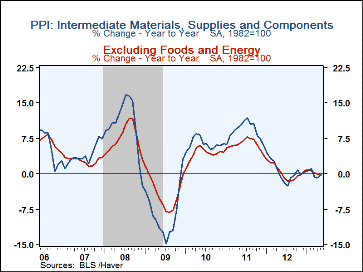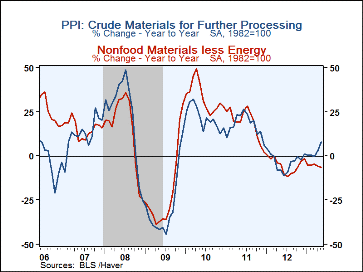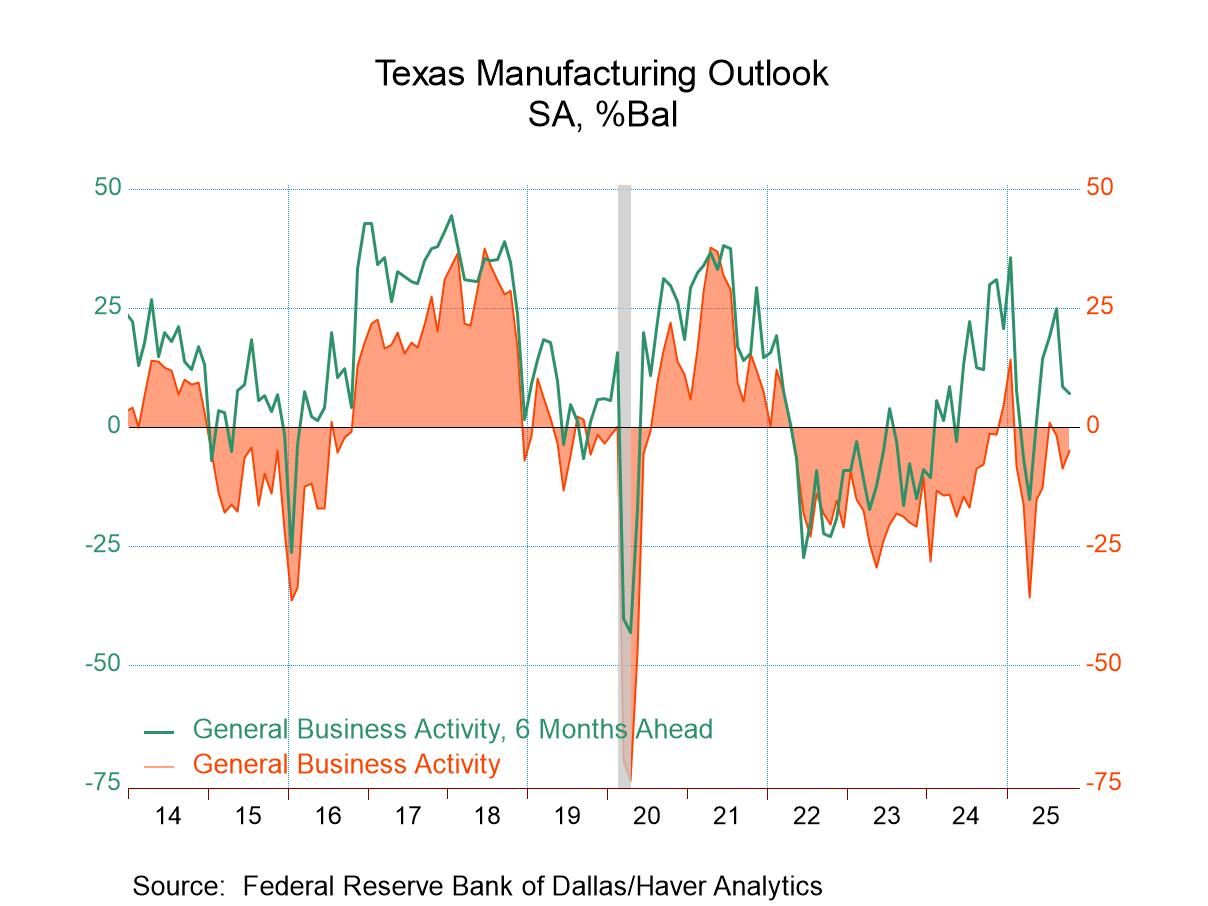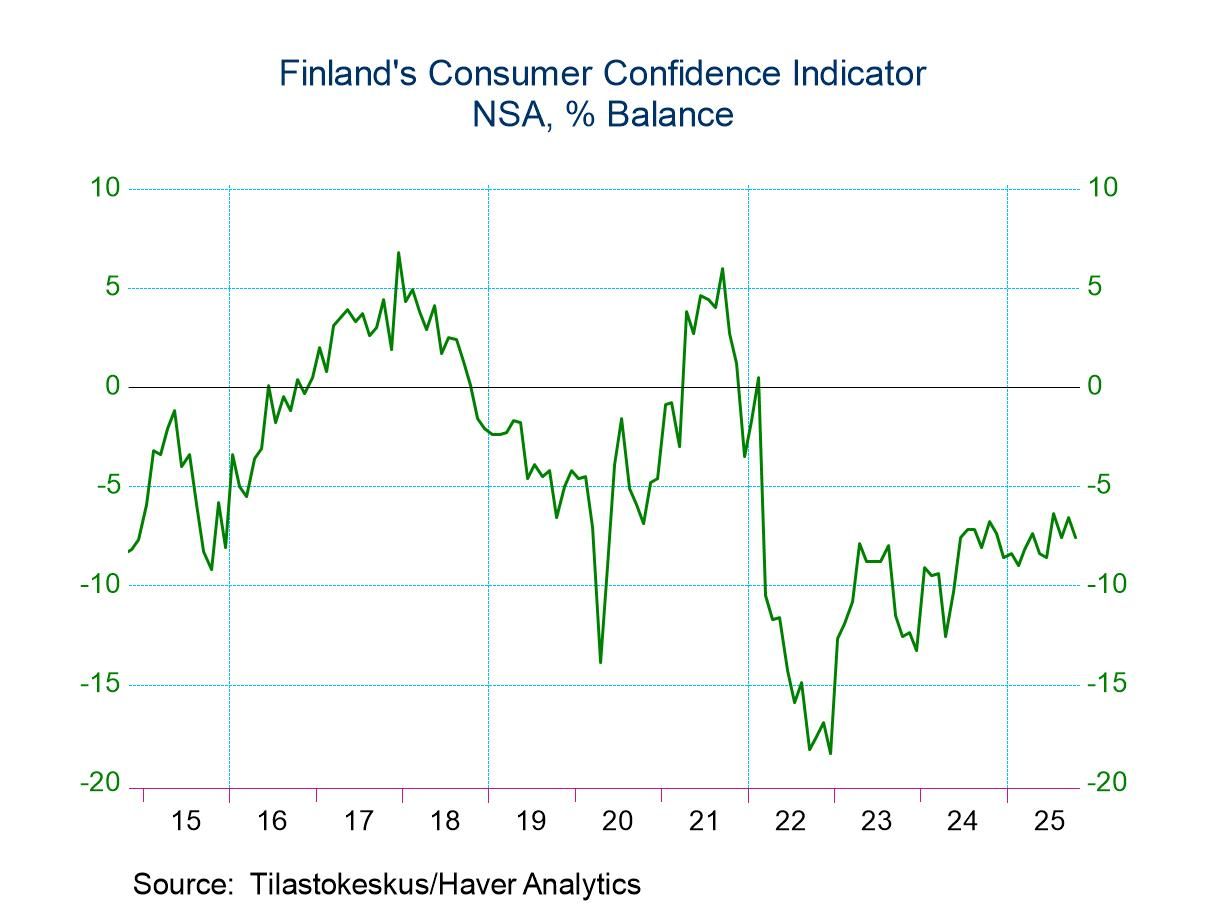 Global| Jun 14 2013
Global| Jun 14 2013U.S. PPI Moves Upward With Energy and Food Prices
by:Tom Moeller
|in:Economy in Brief
Summary
The deflation of wholesale prices ended last month. The producer price index for finished goods recovered 0.5% in May (1.8% y/y) following an unrevised 0.7% April drop. The increase exceeded consensus expectations for a 0.1% uptick. [...]
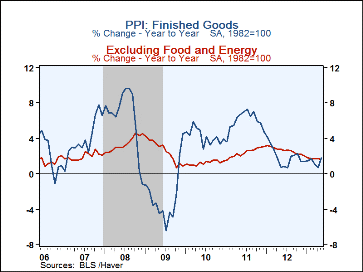 The deflation of wholesale prices ended last month. The producer
price index for finished goods recovered 0.5% in May (1.8% y/y)
following an unrevised 0.7% April drop. The increase exceeded consensus
expectations for a 0.1% uptick. Prices excluding food & energy notched
up an expected 0.1% (1.6% y/y), the same as during April. Higher energy
prices led the increases in overall prices with a 1.3% gain (0.9% y/y).
Gasoline prices rebounded by 1.5% (-2.4% y/y) while home heating oil
prices also reversed course with a 4.9% rise (-8.8% y/y). Residential gas
prices gained another 4.0% (18.3% y/y). Reinforcing the energy price
advances was a 0.6% rebound (3.1% y/y) in food prices. Egg prices soared
41.6% (38.8% y/y) while beef costs recovered 1.0% (1.0% y/y).
The deflation of wholesale prices ended last month. The producer
price index for finished goods recovered 0.5% in May (1.8% y/y)
following an unrevised 0.7% April drop. The increase exceeded consensus
expectations for a 0.1% uptick. Prices excluding food & energy notched
up an expected 0.1% (1.6% y/y), the same as during April. Higher energy
prices led the increases in overall prices with a 1.3% gain (0.9% y/y).
Gasoline prices rebounded by 1.5% (-2.4% y/y) while home heating oil
prices also reversed course with a 4.9% rise (-8.8% y/y). Residential gas
prices gained another 4.0% (18.3% y/y). Reinforcing the energy price
advances was a 0.6% rebound (3.1% y/y) in food prices. Egg prices soared
41.6% (38.8% y/y) while beef costs recovered 1.0% (1.0% y/y).
Finished consumer goods prices gained 0.6% (3.1% y/y) but, excluding food & energy, they ticked up 0.1% (2.3% y/y) as in April. Within the components, women's clothing costs increased 1.7% y/y while men's apparel prices rose 1.9% y/y. Furniture prices rose 1.5% y/y and household appliance prices slipped 0.3% y/y. Passenger car prices declined 0.8% y/y. Capital equipment prices rose edged up a steady 0.1% (0.9% y/y).
Intermediate goods prices slipped 0.1% (-0.2% y/y) as energy costs declined 2.1% (-4.7% y/y). Food prices were off 0.9% (+3.5% y/y) while core intermediate prices fell 0.4% (-0.2% y/y). Crude goods prices recovered 2.2% last month (7.7% y/y) reflecting a 5.0% rise (16.2% y/y) in energy costs and a 2.1% gain (9.6% y/y) in food prices. Prices excluding food & energy fell 2.3% (-6.3% y/y).
The PPI data are contained in Haver's USECON database with further detail in PPI and PPIR. The expectations figures are available in the AS1REPNA database.
| Producer Price Index (%) | May | Apr | Mar | May Y/Y | 2012 | 2011 | 2010 |
|---|---|---|---|---|---|---|---|
| Finished Goods | 0.5 | -0.7 | -0.6 | 1.8 | 1.9 | 6.0 | 4.2 |
| Less Food & Energy | 0.1 | 0.1 | 0.2 | 1.6 | 2.6 | 2.4 | 1.2 |
| Foods | 0.6 | -0.8 | 0.9 | 3.1 | 2.6 | 6.3 | 3.9 |
| Energy | 1.3 | -2.5 | -3.4 | 0.9 | -0.2 | 15.5 | 13.5 |
| Intermediate Goods | -0.1 | -0.6 | -0.9 | -0.2 | 0.5 | 9.0 | 6.4 |
| Less Food & Energy | -0.4 | -0.2 | 0.2 | -0.2 | 0.3 | 6.2 | 4.3 |
| Crude Goods | 2.2 | -0.4 | -2.5 | 7.7 | -3.2 | 17.4 | 21.3 |
| Less Food & Energy | -2.3 | -2.8 | 0.9 | -6.3 | -5.2 | 18.5 | 32.5 |
Tom Moeller
AuthorMore in Author Profile »Prior to joining Haver Analytics in 2000, Mr. Moeller worked as the Economist at Chancellor Capital Management from 1985 to 1999. There, he developed comprehensive economic forecasts and interpreted economic data for equity and fixed income portfolio managers. Also at Chancellor, Mr. Moeller worked as an equity analyst and was responsible for researching and rating companies in the economically sensitive automobile and housing industries for investment in Chancellor’s equity portfolio. Prior to joining Chancellor, Mr. Moeller was an Economist at Citibank from 1979 to 1984. He also analyzed pricing behavior in the metals industry for the Council on Wage and Price Stability in Washington, D.C. In 1999, Mr. Moeller received the award for most accurate forecast from the Forecasters' Club of New York. From 1990 to 1992 he was President of the New York Association for Business Economists. Mr. Moeller earned an M.B.A. in Finance from Fordham University, where he graduated in 1987. He holds a Bachelor of Arts in Economics from George Washington University.


